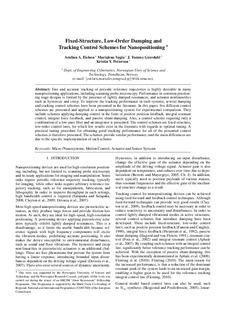| dc.contributor.author | Eielsen, Arnfinn Aas | |
| dc.contributor.author | Vagia, Marialena | |
| dc.contributor.author | Gravdahl, Jan Tommy | |
| dc.contributor.author | Pettersen, Kristin Ytterstad | |
| dc.date.accessioned | 2017-06-08T09:24:32Z | |
| dc.date.available | 2017-06-08T09:24:32Z | |
| dc.date.created | 2013-09-18T09:47:53Z | |
| dc.date.issued | 2013 | |
| dc.identifier.citation | Elsevier IFAC Publications / IFAC Proceedings series. 2013, 28-36. | nb_NO |
| dc.identifier.issn | 1474-6670 | |
| dc.identifier.uri | http://hdl.handle.net/11250/2445407 | |
| dc.description.abstract | Fast and accurate tracking of periodic reference trajectories is highly desirable in many nanopositioning applications, including scanning probe microscopy. Performance in common positioning stage designs is limited by the presence of lightly damped resonances, and actuator nonlinearities such as hysteresis and creep. To improve the tracking performance in such systems, several damping and tracking control schemes have been presented in the literature. In this paper, five different control schemes are presented and applied to a nanopositioning system for experimental comparison. They include schemes applying damping control in the form of positive position feedback, integral resonant control, integral force feedback, and passive shunt-damping. Also, a control scheme requiring only a combination of a low-pass filter and an integrator is presented. The control schemes are fixed-structure, low-order control laws, for which few results exist in the literature with regards to optimal tuning. A practical tuning procedure for obtaining good tracking performance for all of the presented control schemes is therefore presented. The schemes provide similar performance, and the main differences are due to the specific implementation of each scheme. | nb_NO |
| dc.language.iso | eng | nb_NO |
| dc.publisher | Elsevier | nb_NO |
| dc.rights | Attribution-NonCommercial-NoDerivatives 4.0 Internasjonal | * |
| dc.rights.uri | http://creativecommons.org/licenses/by-nc-nd/4.0/deed.no | * |
| dc.title | Fixed-Structure, Low-Order Damping and Tracking Control Schemes for Nanopositioning | nb_NO |
| dc.type | Journal article | nb_NO |
| dc.type | Peer reviewed | nb_NO |
| dc.description.version | acceptedVersion | nb_NO |
| dc.source.pagenumber | 28-36 | nb_NO |
| dc.source.journal | Elsevier IFAC Publications / IFAC Proceedings series | nb_NO |
| dc.identifier.doi | 10.3182/20130410-3-CN-2034.00026 | |
| dc.identifier.cristin | 1050136 | |
| dc.relation.project | Norges forskningsråd: 192427 | nb_NO |
| dc.description.localcode | Copyright © 2013 IFAC. Published by Elsevier Ltd. All rights reserved. This is the authors' accepted and refereed manuscript to the article. | nb_NO |
| cristin.unitcode | 194,63,25,0 | |
| cristin.unitname | Institutt for teknisk kybernetikk | |
| cristin.ispublished | true | |
| cristin.fulltext | postprint | |
| cristin.qualitycode | 0 | |

